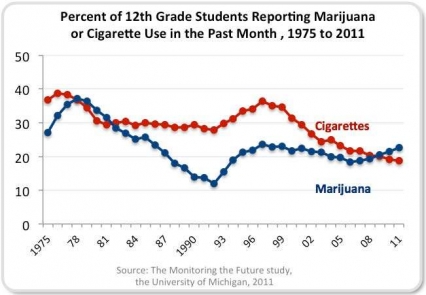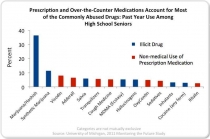The Good News
This year's Monitoring the Future Survey shows historical lows in cigarette and alcohol trends.
- Compared to peak rates in the mid-to-late 1990s, daily cigarette use is down significantly among all three grades, with 2.4 percent of 8th graders, 5.5 percent of 10th graders, and 10.3 percent of 12th graders reporting daily use. From 2010 to 2011, there were also significant declines in current cigarette use (use in the past 30 days) among 10th graders, down from 13.6% to 11.8%, and in smoking a half pack or more per day - now under 2%. Despite these continued decreases, the decline in smoking has slowed in recent years and these levels remain too high given the significant morbidity and mortality associated with tobacco use.
- Likewise, five-year trends showed significant decreases in alcohol use among nearly all grades and across all prevalence periods. For example, binge use of alcohol (defined as 5 or more drinks in a row in the last two weeks) declined from 8.7% to 6.4% among 8th graders, 19.9% to 14.7% among 10th graders and 25.4% to 21.6% among high school seniors from 2006 to 2011. From 2010 to 2011, decreases were observed in lifetime, past year, daily, and binge use of alcohol among 10th graders; lifetime and past year use among 8th graders; and daily use among 12th graders.
- Read the full description of Percentage of U.S. twelfth grade students reporting past-month use of cigarettes and marijuana, 1975 to 2011
-
- Year 1975: Cigarettes 36.7, Marijuana 27.1
- Year 1976: Cigarettes 38.8, Marijuana 32.2
- Year 1977: Cigarettes 38.4, Marijuana 35.4
- Year 1978: Cigarettes 36.7, Marijuana 37.1
- Year 1979: Cigarettes 34.4, Marijuana 36.5
- Year 1980: Cigarettes 30.5, Marijuana 33.7
- Year 1981: Cigarettes 29.4, Marijuana 31.6
- Year 1982: Cigarettes 30, Marijuana 28.5
- Year 1983: Cigarettes 30.3, Marijuana 27
- Year 1984: Cigarettes 29.3, Marijuana 25.2
- Year 1985: Cigarettes 30.1, Marijuana 25.7
- Year 1986: Cigarettes 29.6, Marijuana 23.4
- Year 1987: Cigarettes 29.4, Marijuana 21
- Year 1988: Cigarettes 28.7, Marijuana 18
- Year 1989: Cigarettes 28.6, Marijuana 16.7
- Year 1990: Cigarettes 29.4, Marijuana 14
- Year 1991: Cigarettes 28.3, Marijuana 13.8
- Year 1992: Cigarettes 27.8, Marijuana 11.9
- Year 1993: Cigarettes 29.9, Marijuana 15.5
- Year 1994: Cigarettes 31.2, Marijuana 19
- Year 1995: Cigarettes 33.5, Marijuana 21.2
- Year 1996: Cigarettes 34, Marijuana 21.9
- Year 1997: Cigarettes 36.5, Marijuana 23.7
- Year 1998: Cigarettes 35.1, Marijuana 22.8
- Year 1999: Cigarettes 34.6, Marijuana 23.1
- Year 2000: Cigarettes 31.4, Marijuana 21.6
- Year 2001: Cigarettes 29.5, Marijuana 22.4
- Year 2002: Cigarettes 26.7, Marijuana 21.5
- Year 2003: Cigarettes 24.4, Marijuana 21.2
- Year 2004: Cigarettes 25, Marijuana 19.9
- Year 2005: Cigarettes 23.2, Marijuana 19.8
- Year 2006: Cigarettes 21.6, Marijuana 18.3
- Year 2007: Cigarettes 21.6, Marijuana 18.8
- Year 2008: Cigarettes 20.4, Marijuana 19.4
- Year 2009: Cigarettes 20.1, Marijuana 20.6
- Year 2010: Cigarettes 19.2, Marijuana 21.4
- Year 2011*: Cigarettes 19.0, Marijuana 22.4
* The numbers for 2011 are estimated from the graphic.
Areas of Concern
- While marijuana use declined in the late 1990s and early 2000s, 5-year trends are showing significant increases among 10th and 12th graders for daily, current and past year use. This year, 12.5% of 8th graders, 28.8% of 10th graders, and 36.4% of 12th graders reported past-year marijuana use. Although there were no increases between 2010 and 2011, it appears that marijuana use continues to exceed cigarette use in these students. In 2011, 22.6% of high school seniors used marijuana in the past 30 days compared with 18.7% who smoked cigarettes.
- Attitudes toward substance abuse, often seen as harbingers of change, perhaps could explain these findings. Among all three grades, recent trends show a decline in the perceived risk of harm associated with marijuana use.
- This year's survey captured the use of synthetic marijuana, also known as K2 or "Spice", among high school seniors for the first time. Almost 1 in 9, or 11.4%, of high school seniors reported using Spice in the past year.
- After marijuana, prescription and over-the-counter medications account for most of the top illicit drugs abused by 12th graders in the past year. On the positive side, past-year nonmedical use of Vicodin by 10th graders declined from 7.7% in 2010 to 5.9% in 2011 and the decrease in the use of Vicodin by high school seniors reported last year remained unchanged, albeit at an unacceptably high level of 8.1% in this year's survey. However, OxyContin use remains an area of concern with past-year nonmedical use holding steady across all three grades for the past 5 years. The abuse of stimulants is also cause for alarm. For example, 8.2% of high school seniors reported past-year use of Amphetamines in 2011, up from 6.6% in 2009.
This is also available in PDF format(369KB).
- Transcript: NIDA Director Nora D. Volkow, M.D. on 2011 Monitoring the Future Results
-
Dr. Nora Volkow on the decline in cigarette smoking and the increase of other tobacco products.
Unfortunately what we're observing is that while cigarette smoking is going down, there is still a relatively high rate of the use of other tobacco products like
smokeless tobacco.And the prevalence rates of these other products is actually quite high so while prevention efforts have been beneficial on smoking cigarettes we need to emphasize the importance of also targeting
these other tobacco products.Dr. Nora Volkow on historic decrease in drinking across all grade levels.
We're also observing some of the lowest rates of alcohol drinking behavior among all of the grades; eighth, 10th, 12th grade.
And since 1996 when you have the highest rates of alcohol drinking we've actually seen close to a 50 percent decrease in daily consumption rates of alcohol and we're seeing what, actually,
appears to be a 30 percent decrease in binge drinking behavior which is very problematic because it's the one that's frequently associated with the most adverse consequences.Dr. Nora Volkow on increase in daily marijuana use among 10th and 12th graders.
What we have seen over the past five years is increases in the use of marijuana which has become significant in the 10th and 12th graders and particularly problematic for this year is the indicator
of daily marijuana use that is at its highest that it's been since 1981.And the current daily use of marijuana for 12th graders is 6.2 percent daily use of marijuana.
Dr. Nora Volkow on drop in perceived harmfulness of marijuana.
We're also seeing a decrease in the number of kids that perceive marijuana as harmful. And this is important because throughout the survey we can predict the rate of utilization of marijuana on the basis of kids perceiving the dangers of these drugs.
So the fact that we're seeing increasingly greater number of kids not considering it as problematic predicts that either we do an intervention or the use of marijuana is going to continue going up.
Dr. Nora Volkow on synthetic marijuana use, included in the survey for the first time this year.
And to our surprise the question which was specifically targeted toward 12th graders was they reported 11 percent of them had consumed Spice in the past year. That's one out of nine,
which is also very high and unexpected because it's a new drug so they're willingness to experiment with a new drug for which there's not much experience at such a high level, again, connotes the urgency to address these so we can prevent further escalation.Dr. Nora Volkow on increase in abuse rates of prescription drugs.
Overall we are observing a very high rate of the use of psychotherapeutics, take for example Vicodin which is a pain medication; we had numbers that went as high as 10.5 percent
of 12th graders in the past year having used Vicodin. To the current numbers that are approximately eight percent.Dr. Nora Volkow on NIDA's new PEERx initiative to educate teens about prescription drug use.
Today, we're releasing the updated version of our site for providing information on prescription medication to teenagers, PEERx and we're encouraging the parents and educators and physicians to
speak about it with teenagers and encourage them to look and get the information about what we know on prescription medication.Dr. Nora Volkow on why Monitoring the Future is a valuable public health tool.
Monitoring the Future is an extremely valuable public health tool because it gives us important indicators of the pattern of drug use across the country. And without that knowledge we really do not know how to intervene in terms of prevention efforts and the prevention efforts for substance — for the diversion of substances or the abuse of substances requires strategies that will make, on the one hand, those drugs much less available but on the other one education interventions that make kids aware of the adverse effects of these drugs.


